Color Theory and Application in Interior Design
Color Theory and Application in Interior Design: A Fundamental Element
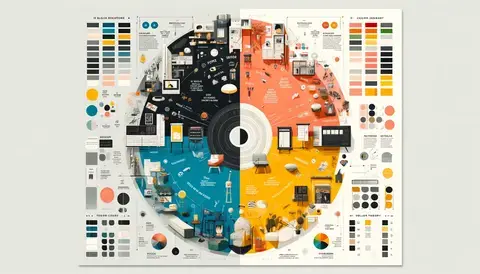
Color is a fundamental element in the world of interior design. It has the power to influence emotions, set moods, and create visual harmony within a space. Understanding color theory and its practical application is a crucial skill for interior designers. In this guide, we'll explore the significance of color in interior design and how to effectively use it to transform spaces.
The Basics of Color Theory
1. The Color Wheel
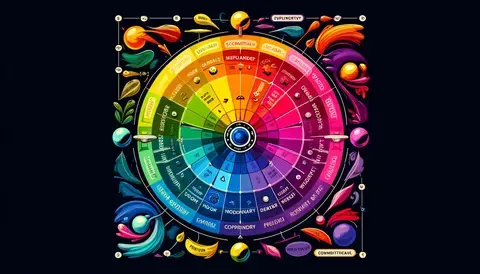
At the heart of color theory is the color wheel. This circular arrangement of colors helps us understand how they relate to one another. The primary colors, red, blue, and yellow, are positioned equidistant from one another on the wheel. These colors cannot be created by mixing others together. By blending primary colors, we get secondary colors, such as green (from blue and yellow), orange (from red and yellow), and purple (from red and blue). Tertiary colors are further combinations of primary and secondary colors.
2. Color Schemes
Interior designers use various color schemes to create visual balance and evoke specific emotions. Here are some common color schemes:
- Monochromatic: This scheme uses variations of a single color. It's a simple and elegant choice, creating a harmonious look.
- Analogous: Analogous color schemes involve using colors that are adjacent to each other on the color wheel. This creates a pleasing, coordinated effect.
- Complementary: Complementary colors are opposite each other on the color wheel (e.g., red and green or blue and orange). They create a dynamic contrast but should be used sparingly to avoid overwhelming a space.
- Triadic: Triadic color schemes involve three colors evenly spaced around the color wheel. This creates a balanced yet vibrant look.
The Psychological Impact of Color
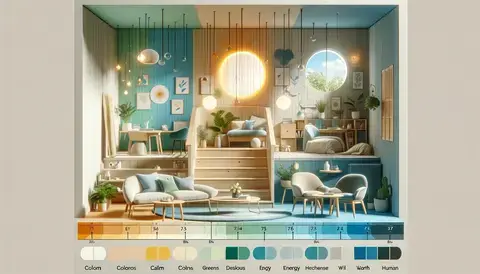
Colors have psychological and emotional effects on people. Here's a glimpse of what various colors can convey:
- Red: Often associated with energy and passion, red can stimulate excitement and create a sense of warmth. It's commonly used as an accent color.
- Blue: Blue is known for its calming and serene qualities. It can promote relaxation and focus. It's a popular choice for bedrooms and offices.
- Yellow: Yellow is cheerful and optimistic, evoking feelings of happiness and energy. It's great for kitchens and dining areas.
- Green: Associated with nature, green can bring a sense of freshness and balance. It's commonly used in spaces meant for relaxation and rejuvenation.
- Purple: Purple signifies luxury and creativity. It can add a touch of sophistication to a space.
- Orange: Vibrant and energetic, orange is often used to create a lively atmosphere in kitchens and playrooms.
Practical Tips for Using Color in Interior Design
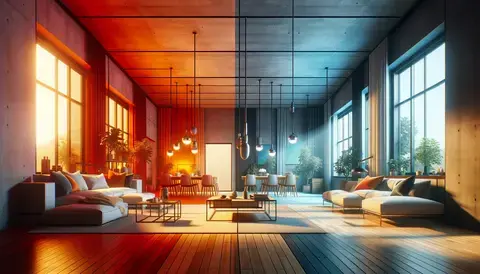
Now that we've covered the basics of color theory, here are some practical tips for applying color in interior design:
1. Consider the Room's Purpose
Think about the function of the space. For example, calming colors like blues and greens work well in bedrooms, while vibrant colors may be suitable for living areas or creative spaces.
2. Balance Warm and Cool Tones
Balancing warm (e.g., red, orange) and cool (e.g., blue, green) tones can create a visually pleasing contrast. This balance prevents a room from feeling too one-dimensional.
3. Use Neutrals as a Foundation
Neutrals like white, beige, and gray serve as a versatile foundation. They allow you to introduce pops of color through furnishings, decor, and accent walls.
4. Test Paint Samples
Before committing to a paint color, it's essential to test samples in the actual space. Paint can look different under various lighting conditions.
5. Create Visual Flow
Consider how colors flow from room to room in an open floor plan. Maintaining a cohesive color scheme helps spaces feel connected.
6. Don't Overlook Small Details
Small details, like the color of throw pillows, artwork, or even door handles, can have a big impact on the overall color scheme of a room.
Case Study: Dramatic Interior Transformation Showcasing the Impact of Color Theory
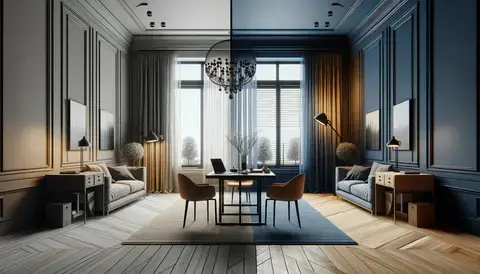
The influence of color in interior design extends far beyond aesthetics; it profoundly affects the atmosphere of a space and the psychological state of its inhabitants. Through a dramatic transformation of an interior using principles of color theory, we can see just how significant these effects can be.
Before the Transformation
Consider a typical room with plain white walls, basic furniture, and minimal accessories. This initial setup, while functional, lacks character and emotional warmth. It serves as a blank canvas, devoid of stimulation or appeal, potentially making the space feel sterile and unwelcoming.
Applying Color Theory
Color theory isn't just about choosing a favorite shade; it's a deliberate process of selecting colors that harmonize to create a desired emotional and visual impact. For this transformation, the color choices are guided by a combination of complementary and analogous color schemes, aimed at invigorating the space without overwhelming it.
- Complementary Colors: By introducing colors that are opposite each other on the color wheel, such as blue and orange, the room gains a vibrant contrast. This not only brings energy into the space but also creates a focal point around which all other elements can harmonize.
- Analogous Colors: Utilizing colors next to each other on the color wheel, like greens and blues, imparts a serene and cohesive look. This scheme is particularly effective in areas meant for relaxation and thoughtfulness.
The Transformation
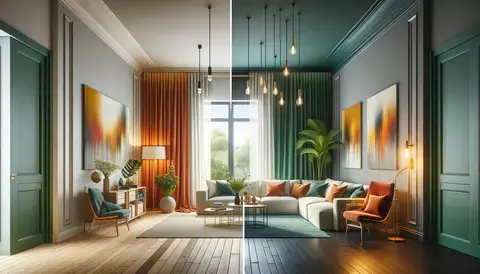
The transformed room features walls painted in soothing sage green, accented with curtains in a vibrant terracotta. The furniture includes touches of deep blue, which complements the earthy tones while adding depth and sophistication. Strategic placement of artwork that features bursts of yellow and orange injects energy and inspires creativity.
The choice of soft, natural fabrics and textures ensures that the visual impact of the colors is enhanced, making the space not only beautiful but also tactilely inviting. Modern lighting fixtures are selected to highlight these colors, casting dynamic shadows and enhancing the room's mood during different times of the day.
Impact on Mood and Functionality
Post-transformation, the room's new color palette dramatically alters its ambiance. The sage green walls provide a calming backdrop, conducive to relaxation and stress relief. In contrast, the terracotta accents bring warmth and vitality, making the space more welcoming and stimulating. This thoughtful use of color significantly enhances the room's functionality—turning it into a versatile environment suitable for both energetic social gatherings and quiet, contemplative moments.
This dramatic transformation showcases the power of color theory in interior design. By understanding and applying the principles of how colors interact and affect us, designers can create spaces that do more than just look good—they can evoke emotions, influence behavior, and transform everyday environments into experiences. Through color, an ordinary room becomes a vivid testament to the impact of thoughtful design.
Why do we have a dedicated section for color theory, and how significant is the topic of color theory?
Color theory is indeed a substantial topic with a variety of aspects to explore. Here are some reasons why color theory can be broad enough to even merit its own detailed section:
Fundamental Concepts: Articles can cover basic principles such as the color wheel, primary, secondary, and tertiary colors, color harmony, and the psychological impacts of color.
Practical Applications: More detailed discussions can focus on how color theory is applied in different types of design like residential, commercial, and healthcare interiors. This could also include case studies and project analyses.
Advanced Techniques: Delving deeper, topics could include color and light interactions, how colors influence spatial perceptions, and color trends in the industry.
Historical and Cultural Contexts: Exploring how color preferences and uses have evolved historically and vary culturally can provide rich content. This section could include articles on color theory in different eras or regions.
Tools and Technology: Coverage of tools used for color design, like color matching software, and technologies used in paint manufacturing and digital design tools.
Workshops and Tutorials: Interactive content such as video tutorials on selecting and combining colors for home décor, creating mood boards, etc.
Here’s how "Color Theory" is structured as its own subcategory:
2. Design
- Interior & Exterior Design
- Color Theory
- Basics of Color Theory: Understanding the Color Wheel, Color Harmony
- Applications in Design: How Colors Influence Mood and Space
- Color Trends: Analysis of Current Trends in Color Use
- Cultural Significance: The Role of Color in Different Cultures and Historical Contexts
- Technological Tools: Software and Tools for Designers
- DIY and Workshops: Step-by-Step Guides and Tutorials for Practical Applications
- Color Theory
Creating a dedicated subcategory for Color Theory under Interior & Exterior Design would not only help in organizing content in a user-friendly manner but also cater to both beginners and advanced learners, ensuring there's enough depth and variety to sustain multiple articles and discussions.
FAQs
1. What is the color theory and application for interiors?
- Answer: Color theory in interior design is a framework that explores the principles and relationships of colors. It involves understanding the color wheel, color harmony, and the psychological impact of colors. The application of color theory in interiors includes selecting and combining colors to achieve specific effects, such as creating visual interest, enhancing mood, or defining spatial elements.
2. What is the application of color theory?
- Answer: The application of color theory involves using the principles derived from the color wheel to create visually appealing and harmonious color schemes. This includes concepts like complementary, analogous, triadic, and monochromatic color schemes. Designers apply color theory to make informed decisions about color combinations, ensuring a cohesive and balanced visual experience in various design contexts, including interiors.
3. What is the application of color psychology in interior design?
- Answer: Color psychology in interior design explores the emotional and psychological impact of colors on individuals. The application involves selecting colors based on their psychological associations to influence mood, behavior, and well-being. For example, warm colors like red and yellow can evoke feelings of energy and warmth, while cool colors like blue and green may promote calmness and relaxation.
4. What is the role of color in interior design?
- Answer: The role of color in interior design is multifaceted. Colors can define the aesthetic identity of a space, establish visual hierarchy, influence the perception of size and proportions, and impact the occupants' emotions. Skillful use of color enhances the overall design concept, creating atmospheres that align with the intended purpose of the space and the preferences of its users.
Color theory and its application are fundamental aspects of interior design. By understanding the principles of the color wheel, psychological effects of colors, and practical tips for using them, interior designers can transform spaces into aesthetically pleasing, harmonious, and emotionally resonant environments. Whether you're aiming for a cozy, serene bedroom or an energetic, vibrant living room, mastering color theory and application is a valuable skill in the world of interior design.
